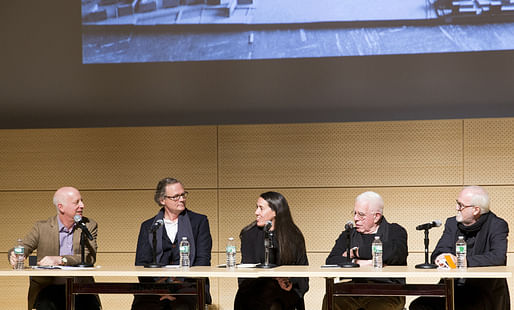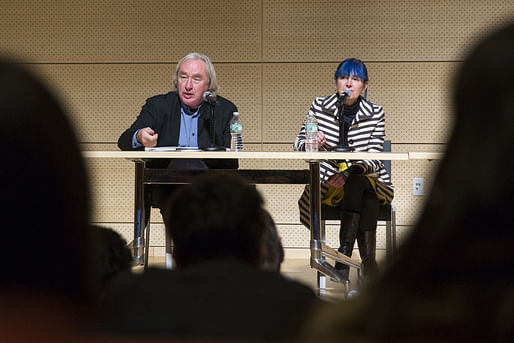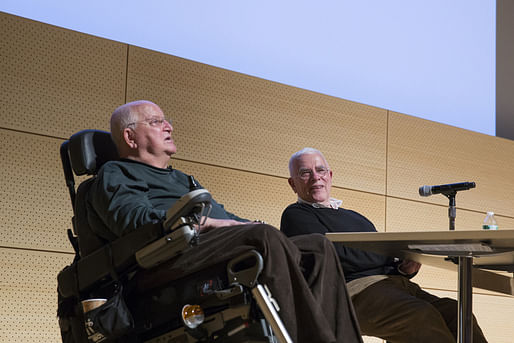
On November 22, the Architectural League hosted Michael Graves: Past as Prologue, a symposium to honor Graves’ 50 years in practice. The all day event was held at Parsons The New School’s brand new Tishman Auditorium on 5th Avenue in New York City. The symposium featured a mix of lectures and panels exploring Graves’ past work, as well as including presentations about a broader diversity of topics still related to Graves, such as the influence of drawing, product design, and medical equipment innovation. Billie Tsien, principal at Tod Williams Billie Tsien and president of The Architectural League, aptly kicked off the day with “We are here to celebrate, but we are also here to think.”

One Part History Lesson / One Part Reunion
The celebration aspect of the symposium was fully realized by the streams of people that gathered around Graves during each of the breaks. Friends, and what can only be described as fans took turns shaking hands and exchanging pleasantries with Graves. When asked what he was most excited about that day, Graves responded “to see old friends, to hear old friends.” The number of Princeton associates and friends and colleagues in attendance at the event created a sense of intimacy.
Francisco Sanin. director of Syracuse Architecture's London program, gave the introductory overview that helped to contextualize Graves’ work, referencing the New York Five, the Roma Interrotta Exhibition in 1978 and the 1980 Venice Biennale, entitled "The Presence of the Past." Sanin explored Graves’ early days at Princeton as well as the network between Peter Eisenmen, Leon Krier, Colin Rowe, Anthony Vidler and many more influential thinkers that helped form architectural pedagogy of the time. This history lesson continued into the panel with Peter Eisenman, David Mohney, Anthony Vidler, Paul Goldberger, and Monica Ponce de Leon. The panel took a trip down memory lane, talking of the irreverent and brash behavior of Eisenman and Graves during their early years at Princeton and how they secured the basement of the School of Architecture from which they influenced many future generations of architects coming out of the school. Stories and anecdotes flew around, giving context to influential projects like the Linear City.

Scale / Diversity
While the full day symposium revolved around Michael Graves, a few of the panels took inspiration from Graves’ impact on the world to explore other topics, while linking themes back to the architect himself. This included a session in which Steven Holl, Mary Ann Ray and Nicholas Olsberg explored “Drawing as Thinking.” Holl, a friend of Graves, and Ray, a student of Graves at Princeton, both presented how drawing has influenced the work in their respective practices. This interlude to showcase the process and work of other architects exemplified how Graves has impacted and helped define a larger pedagogy in architecture. There was a general air of mistrust towards digital production, but the primary focus was using drawing to express and develop ideas, much in the way Graves has done throughout his career.
The issue of scale was brought up throughout the day – speaking about Graves’ designs, which range from multi-story buildings to teapots. Glenn Adamson, director of the Museum of Arts and Design, brought Postmodernism directly into the conversation – showing how Graves related objects to buildings and vice versa, and how Graves allowed for the commercialization and commodification of good design. The matter of scale in terms of Michael Graves extends beyond his work, to his impact on the fields of architecture and product design. Ron Johnson, who helped Graves in producing housewares for Target, and Dean Kamen, an inventor with a heavy focus on medical equipment, showed how Graves’ attitude towards design extends beyond buildings and touches on many aspect of everyday life.

Hot Topic : Michael Graves School of Architecture
Throughout the day there was a smattering of mentions of Kean University’s new Michael Graves School of Architecture. I had the opportunity to quickly catch a word with David Mohney, acting dean of the new school. The school will have one campus in New Jersey and one in Wenzhou, China. Things are moving quickly, with the New Jersey campus intending to be open for Fall 2015, and the Wenzhou campus in 2016. Mohney broke down the numbers saying both schools would be in English and have western accredidation and opportunities to travel between campuses. Each school would have a 4 + 2 degree program, 10 full time and 10 part time faculty members, and a student population of 250 for each campus. Mohney expressed his excitement particularly regarding opening a two campus school.
A Word with Graves
The final conversation of the day was between Graves and Eisenman. I would highly recommend watching this exchange (start at around 1:40 in "Design and Scale") as two old friends exchange jovial, witty remarks. While hilarious, and often grumpy, the exchange was also enlightening as to how Graves intended to have his work impact the world. (He fiercely denied that his work was populist, as Eisenman had “accused” it of being, while Eisenman fiercely denied ever calling Graves’ work populist.)

No Comments
Block this user
Are you sure you want to block this user and hide all related comments throughout the site?
Archinect
This is your first comment on Archinect. Your comment will be visible once approved.